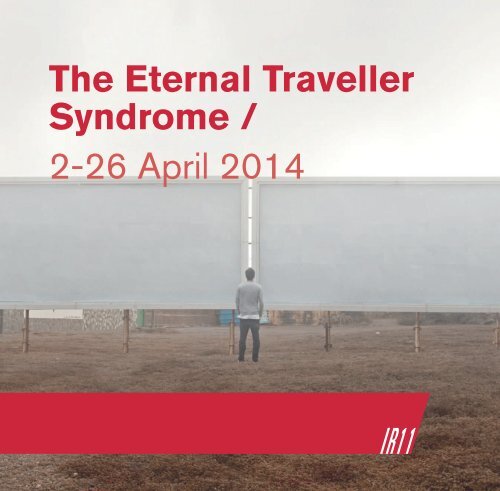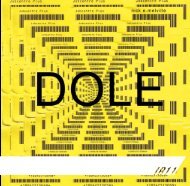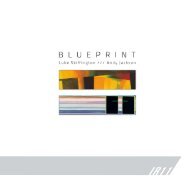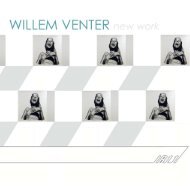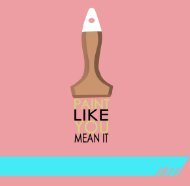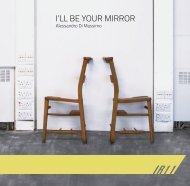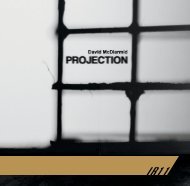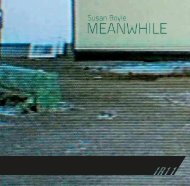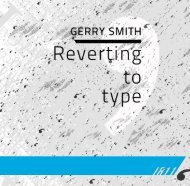The Eternal Traveller Syndrome
This catalogue accompanies: The Eternal Traveller Syndrome © the artists 2015, all the rights reserved.
This catalogue accompanies:
The Eternal Traveller Syndrome
© the artists 2015, all the rights reserved.
You also want an ePaper? Increase the reach of your titles
YUMPU automatically turns print PDFs into web optimized ePapers that Google loves.
<strong>The</strong> <strong>Eternal</strong> <strong>Traveller</strong><br />
<strong>Syndrome</strong> /<br />
2-26 April 2014
<strong>The</strong> <strong>Eternal</strong> <strong>Traveller</strong> <strong>Syndrome</strong><br />
2nd - 26th April 2014 / 2 - 26 abril 2014<br />
Curators / Comisarios<br />
Antonio Cervera & Ana González Chouciño<br />
Artists / Artistas<br />
Carolina Cruz Guimarey, Suso Fandiño,<br />
Ana Gallardo, Joan Morera, Óscar Santana,<br />
Igor Termenón and Damián Ucieda<br />
Organised by / Organizado por
<strong>The</strong> <strong>Eternal</strong> <strong>Traveller</strong> <strong>Syndrome</strong> / El Síndrome del Eterno Viajero<br />
Curators: Antonio Cervera & Ana González Chouciño<br />
he <strong>Eternal</strong> <strong>Traveller</strong> <strong>Syndrome</strong> is the process of returning to one’s home culture ater an extended period<br />
away, and experiencing diiculty in readjusting to an environment previously familiar<br />
When we decide to move abroad, we are not totally<br />
aware of the step we are taking. We are not only<br />
changing our address, but our lives and what surrounds<br />
us. From this moment, we don’t belong anywhere<br />
anymore, or perhaps we belong to everywhere at<br />
the same time.<br />
his process is diferent for everybody. We move for<br />
diferent reasons: maybe we are looking for a job, maybe<br />
we are leeing a sentimental rupture or we simply feel we<br />
have to. But for all of us something has changed forever,<br />
although we need time to notice it.<br />
Once we have assumed the new situation it is the<br />
moment to understand the distance we have created.<br />
he journey back will never take us to the same place.<br />
Airports, buses, trains… real places with symbolic<br />
meaning, called “heterotopias” by Foucault. hose<br />
seats transformed into waiting, become the greatest<br />
metaphor of our new lives. hey are bubbles, islands<br />
that keep us away from all those places we don’t belong<br />
to. From this spot between origin and destination, we<br />
can observe both of them simultaneously, in a kind of<br />
limbo where time has stopped.<br />
Muchos de nosotros, cuando decidimos emigrar, no<br />
somos conscientes del paso que estamos dando. No se trata<br />
solo de cambiar nuestra dirección; estamos cambiando<br />
nuestras vidas y todo lo que nos rodea. Desde ese<br />
momento, ya no pertenecemos a ningún lugar concreto, o<br />
quizás pertenezcamos a todos al mismo tiempo.<br />
Este proceso no es igual para todos. Nos movemos<br />
por diferentes motivos: quizás buscando un trabajo,<br />
quizás intentando superar una ruptura sentimental,<br />
o simplemente porque sabemos que tenemos que<br />
hacerlo. Pero para todos nosotros algo ha cambiado<br />
para siempre, aunque necesitemos tiempo para darnos<br />
cuenta.<br />
Una vez que hemos asumido la nueva situación<br />
podremos entender al in la distancia que hemos creado.<br />
El camino de vuelta nunca nos llevará al mismo sitio.<br />
Aeropuertos, buses, trenes… esos lugares reales<br />
con signiicado simbólico a los que Foucault llamó<br />
heterotopias, esos asientos convertidos en espera, se<br />
convierten en la mayor metáfora de nuestras nuevas<br />
vidas. Son burbujas, islas que nos mantienen alejadas de<br />
esos lugares a los que no pertenecemos. En este punto<br />
entre nuestro origen y nuestro destino podemos observar
Damián Ucieda: Untitled #13. Photograph, 2006 / Untitled #13 (Sin título#13). Fotografía, 2006<br />
he estrangement will persist for a long time and we<br />
will look for diferent strategies to ight it. We will<br />
hang old pictures on our bedrooms’ walls; we will look<br />
for places in the new cities that remind us of the old<br />
one; a patriotic feeling can be reinforced, as well as the<br />
criticism to the corruption that expelled us from our<br />
countries.<br />
All these strategies are used in order to place ourselves<br />
in our context, to reconcile who we have been and who<br />
we have become.<br />
Artists<br />
Carolina Cruz Guimarey, Suso Fandiño, Ana Gallardo,<br />
Joan Morera, Óscar Santana, Igor Termenón<br />
and Damián Ucieda<br />
a ambos al mismo tiempo, en una especie de limbo en el<br />
que el tiempo se ha detenido.<br />
El extrañamiento persistirá por un largo tiempo y<br />
buscaremos diferentes estrategias para combatirlo.<br />
Colgaremos viejas fotos en la pared de nuestra<br />
habitación, buscaremos lugares en la nueva ciudad que<br />
nos recuerde a nuestro antiguo hogar; puede que se<br />
refuerce un sentimiento nacionalista, o la crítica a la<br />
corrupción que nos ha expulsado de nuestros países.<br />
Todas estas estrategias para situarnos de nuevo en<br />
nuestro contexto, para reconciliar a la persona que<br />
hemos sido, con aquella en la que nos hemos convertido.
Kate Mothes<br />
29 January 2015<br />
What makes travel eternal? Indeed, it is an inherent<br />
characteristic of travel that it can have a profound impact<br />
on our education and worldview, providing a string<br />
of opportunities and a new way of seeing. But what<br />
pulls one onto the road, time and time again, luring<br />
us away from the comfort and familiarity of home?<br />
What is home, for that matter, once one has spent time<br />
abroad? he <strong>Eternal</strong> <strong>Traveller</strong> <strong>Syndrome</strong> exhibition at<br />
Interview Room 11, Edinburgh, sought to analyse these<br />
experiences in a photography- and ilm-based exhibition<br />
which the curators described as using ‘diferent strategies<br />
to places ourselves in our context, to reconcile who we<br />
have been and who we have become. 1<br />
he ‘eternal traveller syndrome’ is best described as<br />
wanderlust: the strong desire to explore the world, to<br />
encounter new things each day, and to think on one’s<br />
feet—to live a life less ordinary. Matt Miller wrote, in<br />
response to Jack Kerouac’s Beat manifesto On the Road,<br />
that ‘sometimes it is just enough to point the soul and go,<br />
and keep going, not slowing down to stifen up because<br />
only the dead should be stif. 2 To travel suggests a voyage<br />
of some length, typically abroad or for some distance.<br />
We may spend only an aternoon someplace, or perhaps<br />
¿Por qué nunca dejamos de viajar? Esta “eternidad”<br />
es una característica intrínseca a los viajes que inluirá<br />
en nuestra educación, proporcionará multitud de<br />
oportunidades y una nueva manera de ver el mundo.<br />
¿Pero qué es lo que nos pone en la carretera y otra vez,<br />
alejándonos de la comodidad y familiaridad de nuestros<br />
hogares? ¿Qué es “hogar” cuando ya hemos pasado<br />
demasiado tiempo lejos? La exposición he <strong>Eternal</strong><br />
<strong>Traveller</strong> <strong>Syndrome</strong> en la galería Interview Room 11,<br />
en Edimburgo, intentó analizar estas experiencias a<br />
través de fotografías y video. Según los comisarios, han<br />
usado “todas estas estrategias para situarnos de nuevo<br />
en nuestro contexto, para reconciliar a la persona que<br />
hemos sido, con aquella en la que nos hemos convertido”.<br />
En inglés existe una palabra para el “síndrome del eterno<br />
viajero”: wanderlust: las ganas de explorar el mundo,<br />
de encontrar cosas nuevas cada día, de ingeniárselas<br />
dependiendo de las circunstancias, es decir, vivir una<br />
vida menos ordinaria. En respuesta del maniiesto beat<br />
de Jack Kerouac On the Road, Matt Miller escribió que<br />
“a veces basta con señalar un objetivo y andar, seguir<br />
andando, sin bajar el ritmo para endurecerse porque sólo<br />
los muertos permanecen rígidos”. El hecho de viajar
a few weeks or even years, but every time we pick up<br />
and go somewhere else, we take a bit of one place with<br />
us, and any of the places before, and carry it to the next.<br />
hus, travelling involves an emotional element in which<br />
travellers are forced to explore the world at the same time<br />
as the world shows them more about themselves.<br />
he <strong>Eternal</strong> <strong>Traveller</strong> <strong>Syndrome</strong> showcased artists who relect<br />
their personal experiences<br />
of moving through multiple<br />
places: the impact it had—and<br />
continues to have—on them<br />
over time, their relationships<br />
with others, and their relationship<br />
with and understanding<br />
of the place that they initially<br />
called home.<br />
One memorable piece that<br />
explored movement itself was<br />
Suso Fandiño’s video work<br />
Ephemeral Landscape (2013),<br />
which captured, from the<br />
window of a train, the familiar<br />
whirring and clicking of<br />
the car on the tracks and the<br />
ever-changing view. he acceleration<br />
of the train set trees<br />
and landscapes into a blur, but<br />
with every stop, reiterated as<br />
the video looped, the surroundings<br />
and eventually the next<br />
train platform would inevitably<br />
come into focus. One<br />
can only imagine, rather than see, passengers detraining,<br />
other passengers boarding before they embarked again<br />
and again. As a traveller aboard this train, the journey was<br />
itself eternal, the destination never fully reached.<br />
sugiere un recorrido de una distancia considerable,<br />
normalmente al extranjero. Podemos pasar una sola<br />
tarde en algún sitio, o quizás unas semanas o incluso<br />
años, pero cada vez que nos vamos a un lugar nuevo<br />
llevamos un trocito de este y de los anteriores con<br />
nosotros, hasta la siguiente parada. De esta manera,<br />
viajar implica un elemento emocional en el que los<br />
viajeros son obligados a explorar el mundo al mismo<br />
tiempo que el mundo les<br />
muestra una parte de ellos<br />
mismos. he <strong>Eternal</strong> <strong>Traveller</strong><br />
<strong>Syndrome</strong> está compuesta<br />
por artistas que relejan sus<br />
experiencias personales al<br />
mudarse a diferentes lugares:<br />
el impacto que esto ejerció<br />
(y sigue ejerciendo) a pesar<br />
del tiempo transcurrido, las<br />
relaciones con otra gente y con<br />
el lugar al que inicialmente<br />
llamaron casa.<br />
Una pieza clave que explora<br />
el movimiento en sí mismo<br />
es el vídeo de Suso Fandiño<br />
Ephemeral Landscape (2013),<br />
que captura, desde la ventana<br />
de un tren, el familiar zumbido<br />
y traqueteo del vagón en las<br />
vías y la vista en constante<br />
Joan Morera cambio. La aceleración del<br />
tren difumina los árboles y el<br />
paisaje, pero con cada parada,<br />
reiterada con el vídeo en bucle, la imagen del entorno y<br />
de la siguiente estación inalmente se deinen. Podemos<br />
imaginar, más que ver, pasajeros descendiendo o<br />
embarcando, una y otra vez. Como viajero de este tren, el<br />
viaje es eterno, y nunca llegamos a nuestro destino.
Another theme common to several other works was that<br />
of contemplation and aloneness amidst changes in the<br />
artists’ surroundings or sense of self over time. Many<br />
of the pieces addressed an emotional undercurrent of<br />
transition and relocation rarely emphasized: isolation.<br />
Damián Ucieda’s enigmatic photograph Untitled #13<br />
(2006) depicts a small group of tired passengers on the<br />
upper deck of a city bus, viewed from the perspective<br />
of another traveller aboard another bus. A common<br />
feeling that travellers experience is one in which, though<br />
they ind themselves in crowded public spaces, they feel<br />
invariably and sometimes helplessly alone. Sometimes<br />
the sensation of isolation is leeting, but sometimes it<br />
can last, morph into homesickness, and occasionally<br />
devastate the efort made to enjoy travel for the sake of<br />
the journey.<br />
Returning home is arguably one aspect of the journey<br />
in itself, as travellers oten view home from a diferent<br />
perspective once they have travelled. he things we<br />
associate with home, like family and friends, foods,<br />
brands and so on, are all subject to change during a<br />
traveller’s absence. It might happen that one stays away<br />
so long that home as they knew it is unrecognisable.<br />
Perhaps then home becomes absorbed into the corpus<br />
of places passed through. he traveller turns nomad,<br />
eternally at home on the road. A series of photographs<br />
by Carolina Cruz Guimarey entitled L’attente (Waiting)<br />
(2013) placed herself with her back turned to the lens<br />
in natural landscapes, inhabiting otherwise empty,<br />
ethereal spaces. Another assemblage of small images<br />
by Igor Termenón entitled I Used to Live Here (2009-<br />
14) displayed people, objects and spaces where he had<br />
once lived. Each of these, as with all of the work in<br />
this exhibition, questioned one’s place in a world of<br />
constant transition. Guimarey sits still in a chair as the<br />
world changes around her while Termenón’s series is<br />
a compendium of documented memories. Both move<br />
Otro tema común en varios de los trabajos es la<br />
contemplación del nuevo entorno y la soledad, así como<br />
la percepción de uno mismo a través del tiempo. Muchas<br />
de las piezas se reieren a una tendencia emocional de<br />
esta transición y reubicación a la que raramente se hace<br />
referencia: el aislamiento. Las enigmáticas fotografías<br />
de Damián Ucieda Untitled #13 (2006) representan a un<br />
pequeño grupo de viajeros de apariencia cansada en el<br />
piso superior de un bus, visto desde la perspectiva de un<br />
viajero a bordo de otro bus. Un sentimiento común en<br />
los viajeros es que, aunque se encuentren en lugares con<br />
mucha gente, se siguen sintiendo inevitablemente solos.<br />
A veces la sensación de aislamiento es fugaz, pero otras<br />
vez puede durar demasiado y transformarse en nostalgia,<br />
ocasionalmente puede incluso impedir disfrutar el viaje.<br />
Podría decirse que regresar a casa es una parte inherente<br />
al viaje, ya que los viajeros ven el hogar desde una<br />
perspectiva diferente una vez que se han ido. Lo que<br />
asociamos con hogar, como familia y amigos, comida,<br />
los productos que consumimos, puede que cambien<br />
durante la ausencia del viajero. Puede pasar que uno<br />
pase fuera tanto tiempo que el hogar que ellos conocían<br />
se vuelva irreconocible. Quizás el hogar queda absorbido<br />
por el corpus de lugares por los que vamos pasando.<br />
El viajero se vuelve nómada y la carretera se vuelve<br />
su casa. Una serie de fotografías de Carolina Cruz<br />
Guimarey titulada L’attente (La espera, 2013) retrata a<br />
la propia artista de espaldas a la cámara e inmersa en<br />
un paisaje natural, habitando espacios vacíos y etéreos.<br />
Otro montaje de pequeñas imágenes hechas por Igor<br />
Termenón, tituladas I Used to Live Here (Solía vivir aquí,<br />
2009-14), muestran gente, objetos y espacios en los que<br />
una vez ha vivido. Cada una de estas fotografías, al igual<br />
que el resto de las obras de esta exposición, cuestionan<br />
el lugar que ocupamos en un mundo en constante<br />
transición. Guimarey permanece sentada en una silla<br />
mientras el mundo cambia a su alrededor; por su parte
from place to place, but in diferent ways.<br />
At the time that I went to see this exhibition, I was<br />
living in Edinburgh, pursuing a Masters degree. As<br />
an American in Scotland, I related to the work on a<br />
level that I might not have, had I seen it at home in the<br />
Midwest. he photographic and documentary format<br />
of the selection of work reminded me immediately<br />
of the immense impact of social media on our travel<br />
experiences today.<br />
Online photography and social platforms such as<br />
Instagram, Twitter, VSCOGrid, and countless interactive<br />
photography blogs and networks make it easy for<br />
everyone, no matter where on earth, to share their<br />
everyday experiences with friends and the world. I<br />
adopted this method of sharing my experiences in<br />
Scotland, both of everyday life in Edinburgh as well<br />
as trips elsewhere, to not only capture and save these<br />
moments for posterity, but to access and to help<br />
understand my own emotional response to the transition<br />
from place to place. his exhibition, in the time and<br />
place that I experienced it—itself a part of my own<br />
travels—highlighted how similar our experiences are<br />
despite how vastly diferent our journeys might be.<br />
la serie de Termenón es un compendio de recuerdos<br />
documentados. Ambos se mueven de lugar a lugar, pero<br />
de manera diferente.<br />
Cuando fui a ver esta exposición estaba viviendo en<br />
Edimburgo, ciudad en la que estudiaba un master. Como<br />
norteamericana en Escocia me identiiqué con este<br />
trabajo de una manera que no hubiera sido posible si<br />
estuviese viviendo en mi país. El formato fotográico y<br />
documental de las obras me recordó inmediatamente el<br />
inmenso impacto de las redes sociales en la experiencia<br />
actual de nuestros viajes.<br />
Plataformas sociales como Instagram, Twitter,<br />
VSCOGrid e innumerables blogs de fotografía y redes<br />
sociales convierten en algo muy simple para todos, no<br />
importa en qué parte del planeta, compartir experiencias<br />
cotidianas con amigos de todo el mundo. Yo misma he<br />
adoptado esta manera de compartir mis experiencias en<br />
Escocia, tanto de mi vida cotidiana como mis pequeños<br />
viajes. Lo hago no solo para conservar esos momentos<br />
para la posteridad, sino para tener acceso y ayudarme a<br />
entender mi propia respuesta emocional a la transición de<br />
un lugar a otro. Esta exposición, en el momento y lugar en<br />
el que yo la viví (es también parte de me viaje) me llamó la<br />
atención sobre lo parecida que son nuestras experiencias,<br />
a pesar de lo inmensamente diferentes que pueden ser<br />
nuestros viajes.<br />
1 he <strong>Eternal</strong> <strong>Traveller</strong> <strong>Syndrome</strong> exhibition guide.<br />
2 Matt Miller, “Jack Kerouac and he Satori Highway,”<br />
Literary Traveler, 09 September 2002. http://www.<br />
literarytraveler.com/articles/satorihighwaykerouac.
Carolina Cruz Guimarey<br />
L’attente (Waiting). Photographs, 2013 / L’attente (La espera). Fotografías, 2013<br />
To be still. To be extremely still and silent.<br />
To be alone, still and silent. Seated. Try the<br />
impossible. Again, and again, and again. A<br />
motionless action. A secret action. An action of<br />
observing the movement that does not seem to<br />
exist, a sound that has no sound.<br />
Watch, be still. Listen. Start to escape.<br />
Escape.<br />
Estar quieta. Quedarse muy quieta y en silencio.<br />
Estar sola y quieta y en silencio. Sentada.<br />
Intentar lo imposible. Una vez otra vez otra<br />
vez. Una acción que es la falta de acción. Una<br />
acción secreta. Una acción que es observar el<br />
movimiento que parece que no existe, el sonido<br />
de lo que no tiene sonido.<br />
Mirar. Estar quieta. Escuchar. Comenzar la<br />
huida.<br />
Huir.
Suso Fandiño<br />
Ephemeral Landscape. Video, 2013<br />
Ephemeral Landscape (Paisaje efímero). Vídeo, 2013<br />
A landscape in motion turns into a new<br />
sort of landscape, your perception as a<br />
viewer changes and challenges the way<br />
you face it. Eventually the point: the more<br />
you try the more you are getting close to<br />
fail and somehow succeed in it.<br />
Un paisaje en movimiento se convierte<br />
en otro paisaje, tu percepción como<br />
observador cambia y desafía la manera<br />
en que te enfrentas a él. Esta es la idea:<br />
cuando más lo intentas más cerca estas<br />
de fallar, pero también de tener éxito.
Ana Gallardo<br />
Mi tío Eduardo (My Uncle Eduardo). Video Installation, 2006<br />
Mi tío Eduardo. Vídeo instalación, 2006<br />
78 years old.<br />
He was born in Granada, Spain.<br />
He has lived in Rosario, Prov. De Santa Fe, Argentina, for 50 years.<br />
He never returned to Spain, but he always wanted to.<br />
I proposed to him that we take a trip together. First of all, we would go through the places he always<br />
missed.<br />
We worked together the whole summer planning the routes we were supposed to take.<br />
But, finally, when the time had come, he did not want to travel and I did it on my own, with the guide<br />
we wrote together in my hand.<br />
I arrived in Granada and I filmed all the emotional landscapes he wanted to see again.<br />
In Rosario, finally, he watched all the corners locations in a projection, in the kitchen of his house.<br />
Nació en Granada, España, hace 78 años.<br />
Hace 50 que vive en Rosario, Prov. de Santa Fe, Argentina.<br />
Nunca regreso a España: siempre deseó hacerlo.<br />
Le propuse hacer un viaje juntos. La primera etapa fue de recorrer con la memoria los lugares que<br />
siempre añoró.<br />
Trabajamos durante todo el verano planificando los itinerarios que haríamos.<br />
Finalmente no quiso viajar y lo hice sola, utilizando el planito que el dibujo en mi cuaderno.<br />
Llegue a Granada y filmé los paisajes afectivos con lo que él hubiese deseado reencontrarse.<br />
En Rosario, finalmente vio todos esos lugares en una proyección en la cocina de su casa.
Ana Gallardo<br />
Mi padre (My Father). Video Installation, 2007 / Mi padre. Vídeo instalación, 2007<br />
Looking over my stuff I found a newspaper<br />
clipping. <strong>The</strong> journalist tells of his random<br />
encounter with my parents the day they arrived<br />
in Argentina in 1957.<br />
Just married, they got off the boat that brought<br />
them from Spain to Buenos Aires port. <strong>The</strong>y<br />
took the train that would bring them to Rosario,<br />
their final destination.<br />
My mother was pregnant with me when she took<br />
the train, although she did not know it. I was just<br />
a few days old. With this clipping in my hand,<br />
I approach my father, now 83 years old, and I<br />
ask him to read it aloud. He did not know the<br />
existence of this clipping.<br />
Revisando cosas, encuentro un recorte de<br />
diario que relata un cruce azaroso que tuvo el<br />
periodista que escribe la nota, con mis padres<br />
el día que llegaron a Argentina, en el año 1957.<br />
Recién casados, bajaron del barco que los traía<br />
de España, en el puerto de Buenos Aires, y<br />
tomaron el tren que los llevaría a la ciudad de<br />
Rosario, su destino final.<br />
Mi madre llevaba ya un embarazo de días y de<br />
mí. No lo sabía cuando se tomó ese tren. Con<br />
este recorte en mi mano, me acerco a mi padre,<br />
un hombre en ese momento de 83 años, y le<br />
pido que lea en voz alta este texto, del cual no<br />
conocía de su existencia.
Joan Morera<br />
Vigo-Dakar. Projected Photographs, 2009<br />
Vigo-Dakar. Fotografías proyectadas, 2009<br />
Piece of work made by following the instructions<br />
of a Senegalese citizen residing in Vigo, who<br />
was asked about places in the city which<br />
reminded him of his home country.<br />
Consequently, a number of places in Vigo<br />
evoking the city of Dakar and its area were<br />
photographed.<br />
Vigo-Dakar es un trabajo realizado a partir de<br />
las indicaciones de un ciudadano senegalés<br />
residente en Vigo, al cual se le preguntó acerca<br />
de lugares en la ciudad que le recordaran a su<br />
país de origen.<br />
Así, se fotografiaron en Vigo lugares que le<br />
evocaban la ciudad de Dakar y alrededores.
Óscar Santana<br />
Outsider. Photographs, 2013 / Outsider (Forastero). Fotografías, 2013<br />
In Outsider ignorance coexists with uncertainty.<br />
It is here, in the diary of an Outsider, where I<br />
collect all these concerns in different moments<br />
of my life.<br />
This is how I create my own language, how I write<br />
my own biography through this diary. I want to be<br />
for you a stranger. I want you to realize that I am a<br />
stranger in my country, in any country.<br />
En Outsider la ignorancia coexiste con la<br />
incerteza. Es aquí, en el diario de un Outsider<br />
donde recopilo mis preocupaciones en<br />
diferentes momentos de mi vida.<br />
Así es como creo mi propio lenguaje, como<br />
escribo mi propia biografía en este diario.<br />
Quiero ser un extraño para ti. Quiero que te<br />
des cuenta que soy un extraño en mi país, y en<br />
cualquier país.
Igor Termenón<br />
I Used To Live Here. Photographs, 2009-2011<br />
I Used To Live Here (Solía vivir aquí). Fotografías, 2009-2011<br />
<strong>The</strong> series I Used To Live Here documents the places I lived in between 2009 and 2011. During<br />
those three years I lived in five cities/towns in two different countries. While I was living in those<br />
places the word ‘home’ lost, somehow, its significance to me. I really didn’t know where I was going<br />
to end up next and the photos were an excuse to collect all the memories and try to find a place I<br />
could actually call home.<br />
La serie I Used To Live Here documenta los lugares en los que viví entre 2009 y 2011. Durante estos<br />
años viví en 5 ciudades/pueblos en dos países diferentes. Mientras vivía en estos lugares la palabra<br />
‘casa’ perdió, en cierta medida, su significado para mí. No sabía cuál sería el siguiente paso y las<br />
fotos fueron una excusa para coleccionar todos los recuerdos y encontrar un lugar al que realmente<br />
pudiese llamar “casa”.
Damián Ucieda<br />
Calendario (Calendar). Installation (calendar, 12 polaroids & 2 photographs), 2013<br />
Calendario. Instalación (calendario, 12 polaroids y 2 fotografías), 2013<br />
<strong>The</strong>re is an involved look in Damian Ucieda’s<br />
photographs. With the staging and lighting he<br />
builds a parallel and disturbing ‘truth’, invaded by<br />
enigmas and unresolved questions.<br />
Existe una mirada comprometida en las<br />
fotografías de Damián Ucieda. Mediante la<br />
puesta en escena y la iluminación construye<br />
una “verdad” paralela y perturbadora.
ARTISTAS / ARTISTS<br />
Carolina Cruz Guimarey<br />
Carolina Cruz Guimarey (A Coruña, 1981) is a Spanish artist who works with delicate ephemera and found materials, everyday<br />
objects and natural elements. Cruz’s work revolves around concepts related to memory and identity and are discussed from a<br />
poetic perspective, in many cases following the feminist quote ‘the personal is political’.<br />
Carolina Cruz Guimarey (A Coruña, 1981) es una artista española que trabaja con materiales encontrados, delicados y efímeros:<br />
objetos cotidianos y elementos naturales. Las obras de Carolina, además, investiga conceptos como la memoria y la identidad.<br />
Conceptos que se tratan desde una perspectiva poética y en muchos casos teniendo en cuenta la máxima feminista “lo personal es<br />
político”. Pero sobre todo, su trabajo es frágil y habla de la fragilidad.<br />
Suso Fandiño<br />
Suso Fandiño grew up in Santiago de Compostela. He studied Art History at the Universidad de Santiago de Compostela and Arts<br />
at the Universidad de Vigo. Fandiño takes images and forms from works by well-known and renowned artists and photographers<br />
in ways that undermine conventional notions of originality, artistic mastery and authorship.<br />
Suso Fandiño creció en Santiago de Compostela. Estudió historia del arte en esta ciudad y Bellas Artes en la Universidad de Vigo.<br />
Durante su carrera como artista Suso Fandiño se ha apropiado de imágenes y objetos de conocidos y renombrados artistas y<br />
fotógrafos, socavando de este modo las nociones convencionales de originalidad, maestría y autoría. Por otra parte Fandiño ha<br />
sumado a sus producciones el círculo del mundo del arte como material, sus límites y fronteras.<br />
Ana Gallardo<br />
Ana Gallardo (Rosario, Argentina, 1958) lives and works in Buenos Aires. In 2015 she will participate in the 56th Venice Biennale<br />
and is preparing a solo exhibition based on the last ten years of her practice for the Museo de Arte Moderno de Buenos Aires. For<br />
several years she has organised activities related to the visual arts in Buenos Aires and as a result she has created spaces for the<br />
difusion and relection on contemporary art practices, promoting a dialogue among artists of diferent generations.<br />
Ana Gallardo (Rosario, Argentina, 1958) vive y trabaja en Buenos Aires. Durante el año 2015 participara en la 56° Bienal de Venecia.<br />
Actualmente prepara, además, un recorrido de los últimos 10 años para el Museo de Arte Moderno de Buenos Aires. Desde<br />
hace varios años organiza actividades autogestionadas en la escena de las artes visuales en la ciudad de Buenos Aires, generando<br />
espacios para la difusión y relexión de la practica contemporánea, promoviendo el dialogo entre artistas muy jóvenes, y artistas de<br />
generaciones mayores.
Joan Morera<br />
Joan Morera works with landscape, territory and memory, from a disciplinary point of view. Recently he has undertaken research<br />
in Buenos Aires (Argentina) at the Museo de la Emigración Gallega en Argentina, MEGA (Museum of the Galician Emigration<br />
in Argentina). He collaborates with the contemporary art online magazine Plétora and has worked with institutions as MARCO<br />
(Museum of Contemporary Art, Vigo) and Fundación Serralves, (Oporto, Portugal).<br />
El trabajo de Joan Morera gravita entorno al paisaje, territorio y memoria desde una producción multidisciplinar. Recientemente ha<br />
realizado una estancia de investigación en Buenos Aires (Argentina) en el Museo de la Emigración gallega en Argentina (MEGA)<br />
y colabora con la editorial de arte contemporáneo online Plétora. Su trabajo ha sido expuesto en instituciones como el Museo<br />
MARCO de Vigo o la Fundación Serralves de Oporto (Portugal).<br />
Óscar Santana Omist<br />
Oscar is a traveller, someone constantly searching for a place to feel like the home he let behind. He manages to do so by merging<br />
himself with places, people and their culture. In his photographs he has tries to grasp at something while simultaneously leaving<br />
a bit of himself in each of his works. In his photography, which is no more than ink and paper, he unveils a part of himself, a part<br />
which people who view his work recognise and engage with.<br />
Óscar es un viajero que allá donde va siempre intenta sentirse en casa. Se funde con los lugares, con la gente y con su cultura.<br />
Intenta apropiarse de lo que le rodea al mismo tiempo que deja algo de si mismo en cada foto. En su fotografía, que no es más que<br />
tinta y papel, consigue plasmar sus sentimientos.<br />
Igor Termenón<br />
Igor Termenón is a Spanish photographer living and working in Edinburgh, Scotland. His fashion and portrait work has been<br />
commissioned by clients such as Elle UK, i-D and Vice, and his personal work has been exhibited in galleries across Spain and the<br />
UK.Igor is also the founder and editor of Girls on Film, a self-published ilm photography zine part of the Museum of Modern Art’s<br />
library archive in New York City.<br />
Igor Termenón es un fotógrafo español que vive y trabaja en Edimburgo. Ha realizado fotografías de moda y retratos para clientes<br />
como Elle UK, i-D y Vice, y su trabajo personal ha sido expuesto en galerías españolas y de Reino Unido. Igor es además el<br />
fundador y editor de Girls on Film, revista autopublicada sobre cine y fotografía, que ya forma parte de la biblioteca del Museum of<br />
Modern Art de New York.<br />
Damián Ucieda Cortés<br />
Damián Ucieda Cortés was born in 1980 in A Coruña, Spain. In 2004 he completed his studies in Ilustration from Escola Massana<br />
from Barcelona. He graduated with a BA Hons degree in Photography from Edinburgh College of Art in 2007.<br />
His work has been exhibited internationally in institutions such as Moscow Museum of Modern Art, National Portrait Gallery London,<br />
Royal Scottish Academy, Museo Patio Herreriano of Valladolid, Cidade da Cultura of Santiago de Compostela amongst others.<br />
Damián Ucieda Cortés nació en 1980 en A Coruña, España. En 2004 completó sus estudios en Ilustración en la Escola Massana de<br />
Barcelona. Se graduó con un BA Hons en Fotografía por Edinburgh College of Art en 2007.<br />
Su trabajo ha sido expuesto internacionalmente en instituciones como Moscow Museum of Modern Art, National Portrait Gallery de<br />
Londres, Royal Scottish Academy, Museo Patio Herreriano de Valladolid, Cidade da Cultura de Santiago de Compostela entre otros.
OPENING / INAUGURACIÓN
Our sincere gratefulness / Nuestro sincero agradecimiento<br />
Ángel Villalba, Antonio Garrido, Alberto Condotta, Alice Cathcart, Alice Ogle, Ana<br />
Gallardo, Annika Norrvik, Beatrice heodoratou, Carolina Cruz Guimarey, Carolina<br />
Núñez, Damián Ucieda, Ellyce Moselle, Iberodocs’ team, Igor Termenón, Joan Morera,<br />
Jordi Serret, Kate Mothes, Mar Felices, María del Carmen del Barrio Mendoza, Mirja<br />
Koponen, Óscar Santana, Rafael García Santiago, Rebecca Hughes, Scott McCracken, Suso<br />
Fandiño, Stefania d’Alba, Steph Brown, Úrsula Neilson, Xosé Gago, Xose Ramon Rivas,<br />
Xurxo Salgado, Miguel Utray and Spanish Consulate Edinburgh.<br />
Curators / Comisarios Antonio Cervera & Ana González Chouciño<br />
Artists / Artistas Carolina Cruz Guimarey, Suso Fandiño, Ana Gallardo, Joan Morera,<br />
Óscar Santana, Igor Termenón and Damián Ucieda<br />
Production / Producción IBERODOCS, interviewroom11, Antonio Cervera,<br />
Ana González Chouciño<br />
Organisers / Organizadores IBERODOCS & interviewroom11<br />
Installation / Montaje técnicoAntonio Cervera, interviewroom11’ team & volunteers<br />
Gallery attendant / Asistencia en sala Volunteers<br />
Translations / Traducciones Ana González Chouciño & Mirja Koponen<br />
Graphic Design / Diseño Gráfico Iria Aldrey (www.ialdrey.com)<br />
Textos / Textos Ana González Chouciño & Kate Mothes<br />
Image on cover / Imagen de cubierta Óscar Santana<br />
Of the art works / De las obras © Carolina Cruz Guimarey, Suso Fandiño, Ana Gallardo,<br />
Joan Morera, Óscar Santana, Igor Termenón and Damián Ucieda<br />
Of the articles / De los textos © Ana González Chouciño & Kate Mothes<br />
Of the images / De las imágenes © Igor Termenón and IBERODOCS<br />
© 2015: interviewroom11


